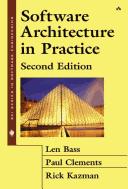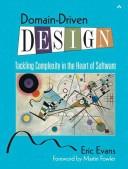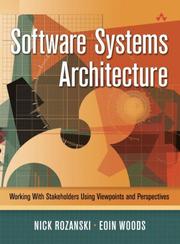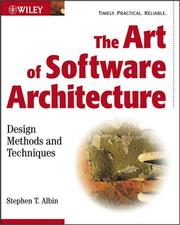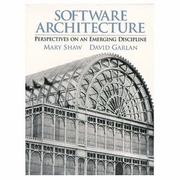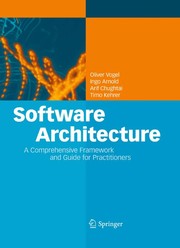Are you a software architect looking to deepen your understanding of the field? Look no further! We’ve curated a list of the 20 best books about software architecture that will elevate your expertise and provide valuable insights. Whether you’re a beginner or a seasoned professional, these books cover a range of topics essential to mastering software architecture. From design principles to practical implementation, each book on software architecture offers unique perspectives and actionable advice. Let’s dive into the world of software architecture books and expand our knowledge together!
Contents
- 1 20 Best Books About Software Architecture
- 2 Clean Architecture: A Craftsman’s Guide to Software Structure and Design
- 3 Software Architecture in Practice
- 4 Designing Data-Intensive Applications
- 5 Domain-Driven Design: Tackling Complexity in the Heart of Software
- 6 Building Microservices: Designing Fine-Grained Systems
- 7 Software Systems Architecture: Working with Stakeholders Using Viewpoints and Perspectives
- 8 Patterns of Enterprise Application Architecture
- 9 The Pragmatic Programmer: Your Journey to Mastery
- 10 Release It!: Design and Deploy Production-Ready Software
- 11 Software Architecture: Foundations, Theory, and Practice
- 12 97 Things Every Software Architect Should Know
- 13 Enterprise Integration Patterns: Designing, Building, and Deploying Messaging Solutions
- 14 The Art of Software Architecture: Design Methods and Techniques
- 15 Software Architecture: Perspectives on an Emerging Discipline
- 16 Just Enough Software Architecture: A Risk-Driven Approach
- 17 Software Architecture: A Comprehensive Framework and Guide for Practitioners
- 18 Building Microservices
- 19 Software Systems Architecture: Working with Stakeholders Using Viewpoints and Perspectives
- 20 Software Architecture for Developers
- 21 Software Architecture in Action
- 22 Conclusion
- 23
- 24 Books about Con Artists Fiction: 2024's Best Titles
- 25 Books about Becoming Leader: 2024 Updated Guide to Essential Reading
- 26 Reading List of Cancer Survivors Books – 2024 Update
20 Best Books About Software Architecture
Clean Architecture: A Craftsman’s Guide to Software Structure and Design
by Robert C. Martin
Clean Architecture: A Craftsman’s Guide to Software Structure and Design by Robert C. Martin is a compelling book on software architecture that emphasizes the importance of creating flexible, maintainable, and scalable software systems. Martin provides valuable insights into the principles and patterns of software architecture, guiding readers through the process of designing robust and adaptable applications. With a focus on practical examples and real-world scenarios, the book offers a comprehensive understanding of how to develop software that is not only functional but also easy to modify and extend. Whether you’re a seasoned developer or a newcomer to the field, this book about software architecture is an essential resource for enhancing your skills and creating high-quality software that stands the test of time.
Software Architecture in Practice
by Len Bass, Paul Clements, Rick Kazman
Software Architecture in Practice by Len Bass, Paul Clements, and Rick Kazman offers a comprehensive and practical guide to the complex world of software architecture. This authoritative book on software architecture provides valuable insights into the principles, techniques, and best practices for designing and implementing successful software systems. With a focus on real-world examples and case studies, the authors delve into the key aspects of architecture design, documenting and analyzing architectures, and evaluating architecture designs. Whether you’re a seasoned architect or a newcomer to the field, this book about software architecture equips you with the knowledge and tools necessary to make informed decisions and create resilient and scalable software systems. It’s an essential resource for anyone looking to deepen their understanding of software architecture.
Designing Data-Intensive Applications
by Martin Kleppmann
Designing Data-Intensive Applications by Martin Kleppmann is a comprehensive and insightful book on software architecture, exploring the principles and practices behind building robust and scalable systems for handling data. Kleppmann delves into the fundamental concepts of distributed systems, data storage, and processing, offering a clear and practical understanding of the challenges and trade-offs involved in designing data-intensive applications. Through real-world examples and case studies, the book provides valuable insights into the complexities of handling data at scale, making it an essential resource for anyone involved in building or maintaining data-driven applications. Whether you’re a software engineer, data architect, or technical manager, this software architecture book is an invaluable guide to navigating the complexities of data-intensive systems.
Domain-Driven Design: Tackling Complexity in the Heart of Software
by Eric Evans
Domain-Driven Design: Tackling Complexity in the Heart of Software, written by Eric Evans, is a renowned book about software architecture that presents a comprehensive guide to building complex software systems. Evans introduces the concept of domain-driven design, emphasizing the importance of focusing on the core domain of the software and collaborating closely with domain experts to create a model that reflects the real-world problem. The book provides valuable insights into strategic design, bounded contexts, and ubiquitous language, offering practical techniques to manage the complexity of software development. With its clear and insightful approach, this software architecture book is a must-read for developers, architects, and anyone involved in building software systems that accurately represent the problem domain.
Building Microservices: Designing Fine-Grained Systems
by Sam Newman
Building Microservices: Designing Fine-Grained Systems by Sam Newman is a comprehensive guide for anyone looking to understand the intricacies of microservices architecture. This book delves into the benefits and challenges of breaking down monolithic applications into smaller, more manageable services. Sam Newman provides valuable insights into the design, deployment, and maintenance of microservices, offering practical advice on how to navigate the complexities of distributed systems. With a focus on scalability, resilience, and flexibility, this book is a must-read for developers, architects, and anyone interested in building modern, cloud-native applications. Whether you’re a seasoned expert or just starting out, this book about software architecture will equip you with the knowledge and tools needed to succeed in the world of microservices.
Software Systems Architecture: Working with Stakeholders Using Viewpoints and Perspectives
by Nick Rozanski, Eoin Woods
Software Systems Architecture: Working with Stakeholders Using Viewpoints and Perspectives is a comprehensive book on software architecture that provides valuable insights into the complex world of designing and implementing software systems. Authors Nick Rozanski and Eoin Woods offer a practical guide for software architecture that focuses on the importance of collaboration with stakeholders and the use of multiple viewpoints and perspectives to ensure successful outcomes. The book covers essential topics such as architectural patterns, design principles, and the role of architects in the development process. With real-world examples and practical advice, this software architecture book is an indispensable resource for architects, developers, and anyone involved in the creation of software systems.
Patterns of Enterprise Application Architecture
by Martin Fowler
Patterns of Enterprise Application Architecture by Martin Fowler is a renowned book on software architecture that delves into the core patterns and principles of building enterprise applications. Fowler, a leading expert in the field, offers valuable insights and practical advice on designing robust, scalable, and maintainable software systems. The book covers a wide range of topics, including data source architecture, business logic, and user interface patterns, making it an essential read for any developer or architect looking to enhance their understanding of software architecture. With its clear explanations and real-world examples, this book about software architecture is a must-have for anyone involved in the design and development of enterprise applications.
The Pragmatic Programmer: Your Journey to Mastery
by Andrew Hunt, David Thomas
The Pragmatic Programmer: Your Journey to Mastery is a renowned book on software architecture that offers invaluable insights and practical advice for software developers looking to master their craft. Written by Andrew Hunt and David Thomas, this book provides a comprehensive guide to becoming a more effective and efficient programmer. It covers a wide range of topics, including coding principles, debugging techniques, automation, and software design. The authors emphasize the importance of continuous learning, critical thinking, and a pragmatic approach to problem-solving. With its clear and engaging writing style, this software architecture book is a must-read for anyone seeking to improve their programming skills and become a more proficient and pragmatic programmer.
Release It!: Design and Deploy Production-Ready Software
by Michael T. Nygard
Release It!: Design and Deploy Production-Ready Software by Michael T. Nygard is a must-read for anyone in the tech industry. This insightful book on software architecture provides practical guidance for building resilient, scalable, and stable systems. Nygard draws on his extensive experience to highlight common pitfalls and patterns that lead to failure in production environments. With a focus on real-world examples and case studies, the book equips readers with the knowledge and tools to design and deploy software that can stand up to the demands of the modern world. Whether you’re a developer, architect, or operations professional, this software architecture book will help you understand the critical aspects of building and maintaining reliable systems.
Software Architecture: Foundations, Theory, and Practice
by Richard N. Taylor, Nenad Medvidović, Eric M. Dashofy
Software Architecture: Foundations, Theory, and Practice is an influential book on software architecture that provides a comprehensive overview of the fundamental principles, theory, and real-world practices of designing and implementing software systems. Written by Richard N. Taylor, Nenad Medvidović, and Eric M. Dashofy, this book about software architecture delves into the essential concepts of architecture, including architectural styles, design patterns, and system quality attributes. It also discusses the process of architecting a software system, covering aspects such as documentation, evaluation, and evolution. With a balance of theoretical foundations and practical insights, this software architecture book is an indispensable resource for software developers, architects, and students looking to deepen their understanding of creating effective and efficient software architectures.
97 Things Every Software Architect Should Know
by Richard Monson-Haefel
97 Things Every Software Architect Should Know by Richard Monson-Haefel is a comprehensive and insightful book on software architecture. It offers 97 concise and practical tips from leading software architects, covering a wide range of topics including design, collaboration, communication, leadership, and technical skills. This book serves as a valuable resource for both aspiring and experienced software architects, providing real-world advice and best practices to navigate the complexities of software development. Each tip is presented in a succinct and easy-to-digest format, making it an ideal reference for architects looking to enhance their knowledge and capabilities. Whether you’re seeking guidance on architectural decision-making, team management, or technical innovation, this book about software architecture has something to offer for architects at any stage of their career.
Enterprise Integration Patterns: Designing, Building, and Deploying Messaging Solutions
by Gregor Hohpe, Bobby Woolf
Enterprise Integration Patterns is a renowned book on software architecture that provides a comprehensive guide to designing, building, and deploying messaging solutions. Authored by Gregor Hohpe and Bobby Woolf, this book offers a practical approach to understanding and implementing integration patterns in enterprise systems. It covers a wide range of topics including messaging, routing, transformation, and system management, making it an essential resource for software architects, developers, and IT professionals. With its clear explanations and real-world examples, this book about software architecture is a valuable asset for anyone involved in building and maintaining complex systems. Whether you’re new to integration or a seasoned expert, Enterprise Integration Patterns offers valuable insights and best practices for creating robust and scalable messaging solutions.
The Art of Software Architecture: Design Methods and Techniques
by Stephen T. Albin
The Art of Software Architecture: Design Methods and Techniques by Stephen T. Albin is a comprehensive book on software architecture that delves into the principles, methods, and techniques for designing effective software systems. The book provides a practical guide for both aspiring and experienced architects, offering insights into the complexities of software architecture and how to navigate them. Albin’s expertise shines through as he explores various design approaches, patterns, and best practices, providing valuable knowledge for creating scalable, maintainable, and adaptable software solutions. Whether you’re a software developer, architect, or engineering manager, this book about software architecture is an essential resource for honing your design skills and enhancing your understanding of the intricate world of software development.
Software Architecture: Perspectives on an Emerging Discipline
by Mary Shaw, David Garlan
Software Architecture: Perspectives on an Emerging Discipline by Mary Shaw and David Garlan is a groundbreaking book on software architecture that provides a comprehensive exploration of the subject. The authors delve into the fundamental principles and concepts of software architecture, offering valuable insights into the emerging discipline. This book about software architecture covers a range of perspectives, from the technical aspects to the human and organizational factors, making it an essential read for anyone involved in software development. With its in-depth analysis and practical examples, this software architecture book is a must-read for software engineers, architects, and anyone interested in understanding the complexities of designing and implementing software systems.
Just Enough Software Architecture: A Risk-Driven Approach
by George Fairbanks
Just Enough Software Architecture: A Risk-Driven Approach by George Fairbanks is a practical and insightful book on software architecture. Fairbanks presents a unique perspective on software architecture, emphasizing the importance of understanding and managing architectural risks in the development process. The book offers a clear and concise framework for making architectural decisions, focusing on mitigating potential risks and ensuring the success of software projects. With its emphasis on practicality and real-world application, this book is a valuable resource for anyone involved in software development, from architects to developers and project managers. Fairbanks’ approach to software architecture is both refreshing and informative, making this book a must-read for anyone interested in mastering the complexities of building software systems.
Software Architecture: A Comprehensive Framework and Guide for Practitioners
by Oliver Vogel, Ingo Arnold, Arif Chughtai
Software Architecture: A Comprehensive Framework and Guide for Practitioners is a must-read for anyone interested in the intricacies of software design and development. This comprehensive book on software architecture provides a deep dive into the principles, methodologies, and best practices for creating effective software systems. Authors Oliver Vogel, Ingo Arnold, and Arif Chughtai offer a wealth of knowledge and practical insights, making this book about software architecture a valuable resource for both seasoned professionals and newcomers to the field. The book covers a wide range of topics, including architectural styles, patterns, and documentation, as well as the role of architecture in agile development and DevOps. Whether you’re a software developer, architect, or manager, this software architecture book will expand your understanding and help you elevate your skills to the next level.
Building Microservices
by Sam Newman
Building Microservices by Sam Newman is a comprehensive guide for anyone looking to dive into the world of microservices architecture. This book on software architecture provides a clear and practical understanding of the principles and best practices for designing and implementing microservices. Newman discusses the benefits and challenges of microservices, along with strategies for breaking down monolithic applications into smaller, more manageable services. He also covers important topics such as communication between services, deployment, monitoring, and security. With real-world examples and valuable insights, this software architecture book is a must-read for developers, architects, and anyone interested in modernizing their software systems.
Software Systems Architecture: Working with Stakeholders Using Viewpoints and Perspectives
by Nick Rozanski, Eóin Woods
Software Systems Architecture: Working with Stakeholders Using Viewpoints and Perspectives is a comprehensive book on software architecture that provides a practical guide for understanding and implementing effective architectural design. Authors Nick Rozanski and Eóin Woods offer valuable insights into the complexities of building software systems, emphasizing the importance of collaboration with stakeholders and the use of multiple viewpoints and perspectives. This book about software architecture covers a wide range of topics, including architectural patterns, design principles, and decision-making processes, making it an essential resource for architects, developers, and project managers. With its clear and accessible writing style, Software Systems Architecture is a must-read for anyone looking to enhance their understanding of software architecture and improve their ability to deliver successful software systems.
Software Architecture for Developers
by Simon Brown
Software Architecture for Developers by Simon Brown is a comprehensive book on software architecture that provides developers with a clear understanding of how to design and communicate the architecture of their software systems. Brown covers key concepts and principles in a practical and accessible way, making it a valuable resource for both experienced developers and those new to the field. The book is filled with real-world examples, case studies, and practical advice, making it an engaging and informative read for anyone looking to deepen their understanding of software architecture. Whether you’re a seasoned developer or just starting out, this software architecture book is an essential guide for mastering the art of designing and communicating effective software systems.
Software Architecture in Action
by Ruth Malan, Dana Bredemeyer
Software Architecture in Action, authored by Ruth Malan and Dana Bredemeyer, is a comprehensive book on software architecture that provides a practical and insightful approach to understanding and applying architectural principles in real-world scenarios. The book delves into the complexities of designing and implementing software systems, offering valuable insights on architectural decisions, patterns, and best practices. With a focus on actionable guidance, the authors cover a wide range of topics, including architectural thinking, design principles, and the role of architecture in organizational success. Through compelling examples and case studies, the book equips readers with the knowledge and tools needed to navigate the challenges of software architecture, making it an essential resource for both aspiring and experienced architects.
Conclusion
In conclusion, these 20 best books about Software Architecture offer valuable insights, practical advice, and in-depth knowledge for both aspiring and experienced software architects. Whether you’re looking to enhance your understanding of architectural patterns, design principles, or system scalability, these books cover a wide range of topics to help you excel in your software architecture endeavors. With the guidance and expertise shared in these books, you’ll be well-equipped to tackle the complex challenges of software architecture and build robust, scalable, and maintainable systems.
Which Software Architecture book is best?
The best book on Software Architecture can vary with personal preference, but three widely recommended titles are:
- Clean Architecture: A Craftsman’s Guide to Software Structure and Design by Robert C. Martin,
- Software Architecture in Practice by Len Bass, Paul Clements, Rick Kazman,
- Designing Data-Intensive Applications by Martin Kleppmann.
Each offers valuable insights and could be a great starting point.
What are the best books to learn about Software Architecture?
For those looking to learn about Software Architecture, there is a wealth of literature that can provide a comprehensive understanding of the subject. Some of the most highly recommended books include:
- Clean Architecture: A Craftsman’s Guide to Software Structure and Design by Robert C. Martin,
- Software Architecture in Practice by Len Bass, Paul Clements, Rick Kazman,
- Designing Data-Intensive Applications by Martin Kleppmann,
- Domain-Driven Design: Tackling Complexity in the Heart of Software by Eric Evans,
- Building Microservices: Designing Fine-Grained Systems by Sam Newman,
- Software Systems Architecture: Working with Stakeholders Using Viewpoints and Perspectives by Nick Rozanski, Eoin Woods,
- Patterns of Enterprise Application Architecture by Martin Fowler,
- The Pragmatic Programmer: Your Journey to Mastery by Andrew Hunt, David Thomas,
- Release It!: Design and Deploy Production-Ready Software by Michael T. Nygard,
- Software Architecture: Foundations, Theory, and Practice by Richard N. Taylor, Nenad Medvidović, Eric M. Dashofy
These books offer a range of perspectives on Software Architecture, covering various aspects and approaches to the subject.
What are the best books on Software Architecture?
The best books on Software Architecture include:
- Clean Architecture: A Craftsman’s Guide to Software Structure and Design by Robert C. Martin,
- Software Architecture in Practice by Len Bass, Paul Clements, Rick Kazman,
- 97 Things Every Software Architect Should Know by Richard Monson-Haefel,
- Enterprise Integration Patterns: Designing, Building, and Deploying Messaging Solutions by Gregor Hohpe, Bobby Woolf,
- The Pragmatic Programmer: Your Journey to Mastery by Andrew Hunt, David Thomas,
- Software Systems Architecture: Working with Stakeholders Using Viewpoints and Perspectives by Nick Rozanski, Eoin Woods.
Each offers unique insights into the subject. While these books on the topic of Software Architecture are highly regarded, it’s important to note that any list of ‘best’ books is subjective and reflects a range of opinions.
What are the best Software Architecture books of all time?
Choosing the best Software Architecture books of all time can vary depending on who you ask, but seven titles that are often celebrated include
- Clean Architecture: A Craftsman’s Guide to Software Structure and Design by Robert C. Martin,
- Software Architecture in Practice by Len Bass, Paul Clements, Rick Kazman,
- Building Microservices: Designing Fine-Grained Systems by Sam Newman,
- The Pragmatic Programmer: Your Journey to Mastery by Andrew Hunt, David Thomas,
- Software Architecture: Foundations, Theory, and Practice by Richard N. Taylor, Nenad Medvidović, Eric M. Dashofy,
- Enterprise Integration Patterns: Designing, Building, and Deploying Messaging Solutions by Gregor Hohpe, Bobby Woolf,
- and 97 Things Every Software Architect Should Know by Richard Monson-Haefel.
Each of these books has made a significant impact in the field of Software Architecture and continues to be influential today.


